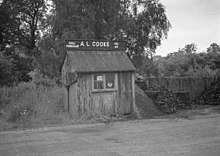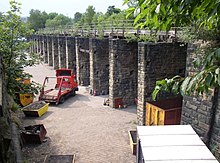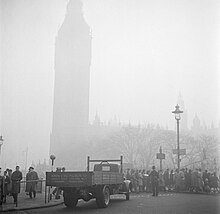Coal merchant

A coal merchant is the term used in the UK and other countries for a trader who sells coal and often delivers it to households.[1][2] Coal merchants were once a major class of local business, but have declined in importance in many parts of the developed world due to the rise of alternative heating methods, including central heating, gas, oil and electric heating.[3] The men who carried the coal to households were called coal men.[4][5]
The mass of coal homes burned was large; the UK government estimated in 1975 that the average household burning solid fuel used about 4.7 tons per year.[6]
History
According to J. U. Nef, the term "coal merchant" originally meant "the owner, or part owner, of an east-coast collier [ship]; but in the eighteenth century the word was applied to all kinds of London coal traders, including small retailers", while the shipper came to be called a coal dealer, although the terms were "seldom applied consistently" in this period.[7]

From the coming of the railways, coal merchants in the UK were typically based at railway stations in the goods yard, with coal delivered by train.[1][8][9] Other possibilities were delivery by canal boat or by collier ship,[1][10] or direct sale from the colliery in areas close to one, known as "landsale".[11][12] The coal would then be transferred by cart or truck to local homes and businesses, sometimes into a coal hole, a hatch leading down to the cellar.[13][14]


Coal merchants in the railway era were typically small local businesses, although larger dealers did exist,[1] and might buy their coal from a coal factor, also called a coal broker.[15] According to John Armstrong, in London there was a "rough implicit division" with coal consignments to individual local coal merchants coming by railways while large power stations and factories, often near the Thames, received it by collier ship.[16][17]
There was a risk of occupational injury from the back-breaking work of carrying the heavy sacks of coal.[4][18] Liz Barclay reports that in Gelderland in the Netherlands it was common for deliveries to be done in summer when it was dry to stock up for winter to reduce dirt coming into the house.[18]
Post-war period

During the post-war austerity period the nationalised National Coal Board promoted poor-quality "nutty slack" coal for consumer use so that higher quality coal could be exported or used elsewhere.[19] The Clean Air Act 1956 attempted to switch UK consumption away from this towards smokeless fuel.[20] In 1962 the NCB and traders set up a Coal Trade Code and promoted an "Approved Coal Merchant" mark, which continues to exist as of 2022.[21]

From the 1950s, British Railways reduced wagonload freight to individual railway stations as part of the Beeching cuts, with supply to UK coal merchants often switching to delivery by road from large "coal concentration depots" where coal was unloaded from block trains.[22][23][24] However, coal merchants often stayed trading in station yards.[25][26]

Decline of rail shipment of coal generally led to the closure of concentration depots around the 1990s.[27][28]
Coal merchants have declined due to new heating methods.[20][18] Explaining his decision to sell his business in Swindon in 2015, one commented "business was good but it wasn’t growing any more. With the introduction of natural gases to Swindon and electric cookers, demand was slowing."[3]
See also
References
- ^ a b c d Emm, Adele (30 April 2015). Tracing Your Trade & Craftsman Ancestors: A Guide for Family Historians. Pen and Sword. pp. 46–51. ISBN 978-1-4738-2362-4.
- ^ "Coal Deliveries". Croxley Green History Project. Croxley Green History Group. Retrieved 3 May 2023.
- ^ a b Buckland, Eve (20 April 2015). "Swindon's only remaining coal merchant to close after 114 years". Swindon Advertiser. Retrieved 3 May 2023.
- ^ a b Martinelli, Terry. "The work of coalmen when coal was the nation's main fuel". 1900s.org.uk. Retrieved 7 May 2023.
- ^ Cryer, Pat. "Coal delivery to houses and flats mid-20th Century". 1900s.org.uk. Retrieved 7 May 2023.
- ^ Eadie, Alex (3 March 1977). "Coal Consumption". Hansard. Retrieved 5 May 2023.
The total number of solid fuel consuming households in the United Kingdom in 1975 was estimated to be 3·3 millions and the total solid fuel disposals to the domestic sector in the same year was 15·5 millions tons, giving an annual average of about 4·7 tons per solid fuel consuming household.
- ^ Nef, J. U. (11 January 2013). The Rise of the British Coal Industry. Routledge. p. 84. ISBN 978-1-136-23529-0.
- ^ Yorke, Trevor (19 March 2020). Tracing Lost Railways. Bloomsbury Publishing. p. 44. ISBN 978-1-78442-372-8.
- ^ Richards, J. M. (18 August 2011). The Castles on the Ground: The Anatomy of Suburbia. Faber & Faber. ISBN 978-0-571-28160-2.
- ^ Knowles, L. C. A. (3 November 2005). The Industrial and Commercial Revolutions in Great Britain During the Nineteenth Century. Taylor & Francis. pp. 251–252. ISBN 978-0-415-37918-2. Retrieved 5 May 2023.
- ^ Boardman, E. Lloyd. "Glossary of Mining Terms". Apedale Heritage Centre. Retrieved 5 May 2023.
- ^ Wain, Ken (15 September 2014). The Coal Mining Industry in Barnsley, Rotherham and Worksop. Amberley Publishing Limited. ISBN 978-1-4456-3977-2.
- ^ Cowan, Rob (2017). "Iron, glass and wood underfoot". Context (152). Institute of Historic Building Conservation: 18–22.
- ^ Hall, Marshall (31 August 2021). Blimey, I'm Knackered!: An American's Survival Guide to British English (in Arabic). Imbrifex Books. ISBN 978-1-945501-50-0.
- ^ Winter, Jay; Robert, Jean-Louis (8 July 1999). Capital Cities at War: Paris, London, Berlin 1914-1919. Cambridge University Press. pp. 348–349. ISBN 978-0-521-66814-9.
- ^ Armstrong, John (2000). "From Shillibeer to Buchanan: Transport and the Urban Environment". In Daunton, Martin (ed.). The Cambridge Urban History of Britain. Cambridge University Press. p. 233. ISBN 978-0-521-41707-5. Retrieved 5 May 2023.
- ^ Batten, Malcolm (5 May 2022). Shipping on the Thames and the Port of London During the 1940s – 1980s: A Pictorial History. Pen and Sword Transport. pp. 96–100. ISBN 978-1-3990-1843-2.
- ^ a b c Barclay, Liz (2016). The Farmer, the Coal Merchant, the Baker: A Personal Impression of the Development of the Gelderland Horse World. YouCaxton Publications. pp. 79–87. ISBN 978-1911175285.
- ^ Thorsheim, Peter (16 April 2018). Inventing Pollution: Coal, Smoke, and Culture in Britain since 1800. Ohio University Press. ISBN 978-0-8214-4627-0.
- ^ a b Paxman, Jeremy (2021). Black Gold: The History of How Coal Made Britain. William Collins. p. 266. ISBN 9780008128364.
- ^ "approved coal & wood merchants". Solid Fuel Association. Retrieved 5 May 2023.
- ^ Bennett, Patrick (15 June 2018). The Architecture and Infrastructure of Britain's Railways: Northern England and Scotland. Amberley Publishing Limited. ISBN 978-1-4456-8140-5.
- ^ Mitchell, David (30 June 2022). Devon's Railways: North and East of the County. Key Publishing. ISBN 978-1-80282-119-2.
- ^ Brandon, David; Upham, Martin (30 March 2022). Ernest Marples: The Shadow Behind Beeching. Pen and Sword Transport. p. 200. ISBN 978-1-5267-6021-0.
- ^ Lewis, Ron; Fraser, Tom. "Coal Depots (Closure)". Hansard. Retrieved 11 May 2023.
- ^ Thomas, David St John (6 February 2014). The Country Railway. Frances Lincoln. ISBN 978-1-78101-164-5.
- ^ Hodge, John (31 May 2016). Railways and Industry in the Western Valley: Newport to Aberbeeg. Pen and Sword. ISBN 978-1-4738-7023-9.
- ^ Rhodes, Mike (15 February 2023). MGR Coal Trains. Amberley Publishing Limited. ISBN 978-1-3981-0889-9.
The Deepdale Coal Concentration Depot in Preston was one of the last in the UK to receive coal by rail...1994...was the last year in which the train ran.
